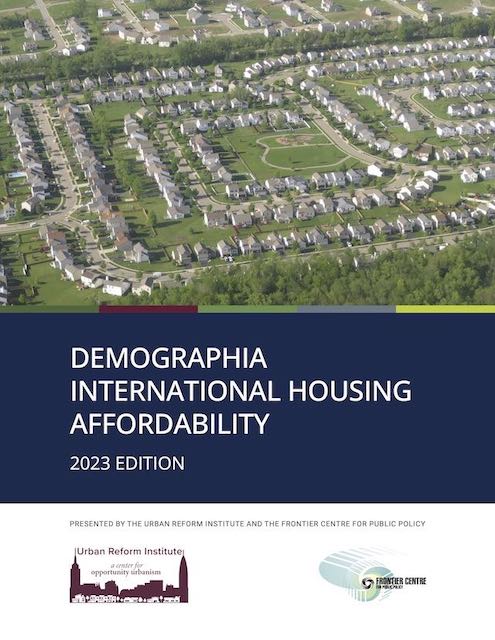“Housing affordability in 2022 continued to reflect the huge price increases that occurred during the pandemic demand shock,” reports demographer Wendell Cox in his 2023 international housing affordability report. “Some housing affordability improvements have since occurred and more are likely as the demand shock is hopefully replaced by more normal market trends.”
Click image to download a 3.6-MB PDF of this 26-page report.
Cox measures housing affordability in more than 90 urban areas located in Australia, Canada, Hong Kong, Ireland, New Zealand, Singapore, the United Kingdom, and the United States by dividing median home prices with median household incomes. I use the same measure except I use median family incomes, which are readily available through 2021 using U.S. census data. Cox probably uses household incomes because they are more readily available for 2022 and in other countries. This is the latest update of a series of reports going back to 2005 (with data for 2004).
Using these measures, any market whose home prices are more than five times median incomes is unaffordable because, using standard mortgage rules (which allow people to spend no more than 30 percent of their incomes on housing) no one can get a loan for a house that costs five times more than their income without making a giant down payment. Unfortunately, supply-chain and labor shortages resulting from the pandemic have pushed many housing markets that were affordable — home prices less than 3 times incomes — into unaffordable and marginally unaffordable (prices 3-5 times incomes) territory.
The pandemic also led to a major migration of people that most local housing markets weren’t ready to absorb, and thus prices rose in many places. In general, prices fell in dense cities and rose the most in low-density suburbs, cities, and urban areas. Cox’s report tracks only urban areas so doesn’t show the changes between dense cities and their suburbs. Yet even if prices fell in some markets, if the wealthier people in those markets moved out, then median incomes also fell and the markets remained unaffordable.
Cox’s data show that almost every urban area was less affordable in 2022 than 2019. The biggest exception I can find is Hong Kong, which went from an outrageously unaffordable 20.8 to an almost as outrageously unaffordable 18.8. I may have missed one or two, but the only other exceptions I can find are Newcastle, England, whose affordability improved slightly from 4.5 to 4.4, and Middleborough & Durham, England, whose affordability remained the same at 4.7.
In response to housing affordability problems, many governments are stepping up subsidies to affordable housing. But affordable housing, which means building subsidized housing for a few truly low-income people, doesn’t make housing more affordable for everyone else. This is like using a screwdriver for a job that requires a sledgehammer.
Eventually, the labor and supply-chain problems will be resolved, but housing will remain unaffordable in some regions. Cox doesn’t blame those affordability problems on single-family zoning. The report quotes the former governor of New Zealand’s central bank, who says “the affordability of housing is overwhelmingly a function of just one thing, the extent to which governments place artificial restrictions on the supply of residential land.” Lifting those restrictions on undeveloped areas, not changing zoning of areas that are already developed, is the key to making housing affordable again.








